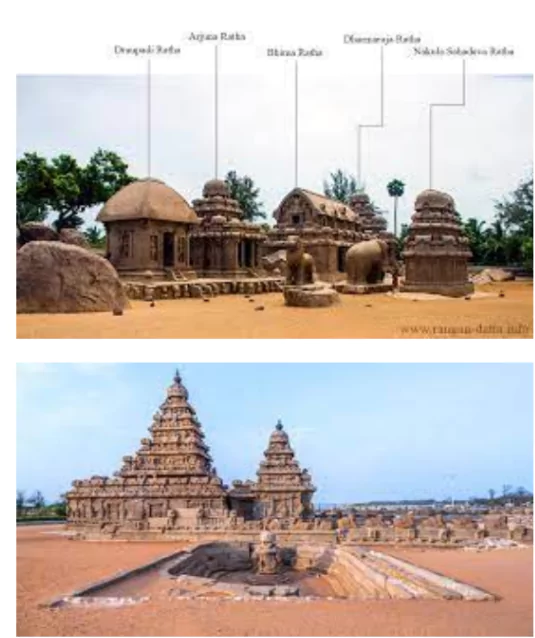The Pallavas (2nd century AD, Andhra region), migrated south to Tamil Nadu, leaving a significant architectural legacy.
Pallava Architecture
- Region: The Pallavas, active from the second century CE in the Andhra region, migrated south to Tamil Nadu, leaving a significant architectural legacy.
- Initial Structures: Initially, rock-cut structures attributed to Mahendravarman I coexisted with structural buildings, showcasing early mastery in both forms.
Classification of Pallava Architecture
The temple architecture in South India began under the Pallava rulers and can be classified into 4 stages:
Enroll now for UPSC Online Course
-
- The first stage of Pallava architecture was basically rock-cut temples.
- Mahendravarman claims in his Mandagappattu inscription that his shrine to Brahma, Isvara and Vishnu was made without using traditional materials such as brick, timber, metal and mortar.
- Temples are usually the mandapa type with a pillared hall or the mandapa in front and a small shrine at the rear or sides.

-
- The rock-cut temples were decorated with intricate sculptures.
- Under Narasimhavarman I, Panch Pandava Rathas were built, the biggest one being the Dharmaraja Ratha.
- The Dravidian style of Temple architecture is a successor of Dharmaraja Ratha.
-
- Under him development of real structural temples took place.
- Example: Shore temple at Mahabalipuram was built in the reign of Narasimhavarman II, also known as Rajasimha(8th Century) and Kailasanatha temple at Kanchipuram etc.
-
- The temples were smaller in size.
- The features were almost similar to the Dravidian style of temple architecture.
Mahabalipuram [UPSC 2014, 2015, 2016]
- This 7th-century Pallava site was declared a UNESCO World Heritage Site.
Important monuments at Mahabalipuram:
- Pancha Pandava Rathas: These are the earliest rock-cut temples Built under the patronage of Narasimhavarman I (630-668 AD) and comprise Dharmaraja ratha, Bhima ratha, Arjuna ratha, Nakula and Sahadeva ratha.
- Rock-cut cave temples: Varaha cave temple, Krishna cave temple, Pancha Pandava cave temple and Mahishasuramardini Mandapa.
- Open Air Rock Reliefs: Include the Descent of Ganges, also known as Arjuna’s penance or Bhagiratha’s penance.
- Shore temple complex: It has two small and one large temple. The temple is predominantly dedicated to Lord Shiva, with a sculpture of Anantashayana (Vishnu) in one of the three temples.
- The compound includes evidence of a water tank, early gopuram, and sculptures of Nandi, though erosion has affected some carvings.
Varahamandapa Cave: It is behind the Arjuna’s Penance having the following features:
- The front hall has two-lion pillars.
- One of the panels represents Varaha raising the Earth from the ocean.
- A remarkable feature is the snout of the boar.
|
Enroll now for UPSC Online Classes
Conclusion
- Through their visionary contributions, the Pallavas not only shaped South Indian architecture but also laid the foundation for the development of diverse temple styles that endure to this day.
![]() April 18, 2024
April 18, 2024
![]() 5409
5409
![]() 0
0
